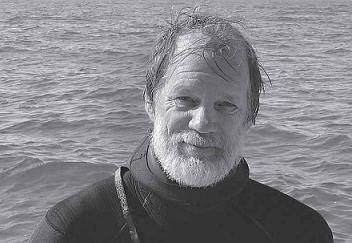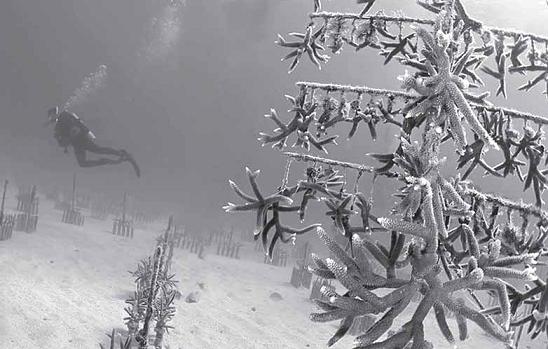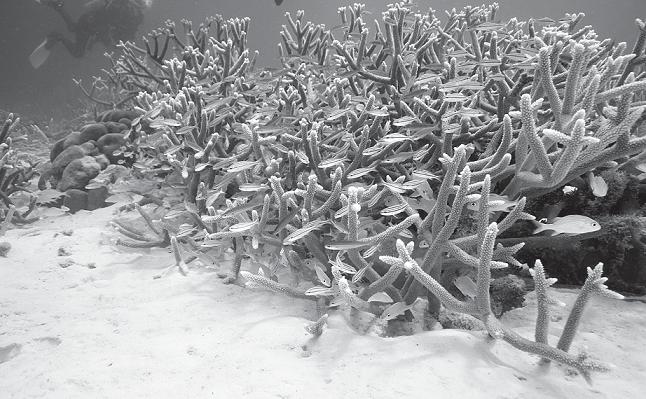Protecting the 'rainforests of the sea'
abracad, · Categories: environment, externally authoredInterview with Ken Nedimyer
by Jason Francis
Ken Nedimyer, founder of the Coral Restoration Foundation, discusses the ecology of the biologically diverse coral reefs, the ways in which CRF is rebuilding them, and efforts to educate the public as to the human impact on these critical oceanic resources.
The Coral Restoration Foundation (CRF) is a nonprofit conservation group based in Key Largo, Florida, that develops offshore coral nurseries and reef restoration programs for critically endangered coral reefs at local, national and international levels. Tens of thousands of corals are grown and maintained in multiple offshore nurseries. With the help of students, volunteers, scientists, dive operators, public aquariums, and community groups, thousands of corals grown in CRF's nurseries have been replanted on degraded coral reefs. Ken Nedimyer, a commercial fisherman and tropical fish collector, formed CRF in 2007. Jason Francis interviewed Nedimyer for Share International.

Ken Nedimyer
Share International: What is coral and why are coral reefs called the 'rainforests of the sea'?
Ken Nedimyer: Coral is an animal, but it is more than that. A coral colony is a bunch of polyps, which are the animal, but inside the coral are symbiotic algae that provide most of their food, as well as a bacterial community. The algae and bacteria work together to keep a coral alive.
Coral reefs are called the 'rainforests of the sea' because of their extremely rich biological diversity. They cover less than one per cent of the ocean's surface area, but are home to about 25 per cent of the ocean's species. Coral reefs are also like rainforests because they are in danger from human impacts and are being over-exploited and encroached upon.
SI: What is causing coral reefs in the Caribbean to diminish?
KN: Decades of over-fishing have had a huge impact on some of the reefs. Near-shore or land-based pollution, including sewage and runoff from agriculture, have also impacted them. (Only 20 per cent of Caribbean countries have adequate sewage treatment and the rest have inadequate or no sewage treatment at all.) Construction along rivers and shorelines has caused erosion, which produces silt that buries the reefs. Coral reefs cannot handle silt well. And in the Caribbean there was a region-wide die-off, a mass extinction, of an important herbivorous sea urchin in 1983, which had a major impact. It disrupted the reproduction and life cycles of coral and fish.
Coral bleaching has occurred during the past 20 to 25 years, which has led to widespread disease and coral loss in the region. I mentioned that coral is primarily an animal, but it has a symbiotic algae living inside it. The algae give coral its color. If it didn't have the algae, the coral would be white. Deep-water corals tend to be white because they don't have algae. There are different strains of algae and some will cause the coral to look pink, purple or blue, but in the Caribbean most are brown.
When the corals are stressed from heat or cold, but primarily from extended periods of hot water, they expel the algae. When they do that they turn white. They don't necessarily die right away, but they have kicked out their main source of food. So they tend to become more and more stressed and stay bleached. Corals can recover from the bleaching, and they do, but it weakens them and they are susceptible to infection, diseases and all kinds of secondary effects once they have bleached. Bleaching and disease are also impacting areas outside the Caribbean. All of these factors are impacting populated areas around the world. Since the entire Caribbean basin is fairly well-populated, and a closed basin in some respects, it is particularly vulnerable.
SI: Does the hot water have anything to do with global warming?
KN: The changing climate has played a part in it. Most of the extreme bleaching events have been associated with El Niño in the South Pacific, which is basically a wind direction shift. It disrupts global temperatures and wind patterns. Every time we have had a major bleaching it's been because of a strong El Niño. An already rising global temperature has intensified the severity of those events. Instead of an El Niño event causing the temperature to get warm but not too warm for a coral, the temperature is exceeding that threshold more often than in the past. In recent history the El Niño events have caused more bleaching than they previously did.
SI: Is this degradation happening to reefs around the world?
KN: Some reefs are holding up fairly well and the decline has been minimal or almost imperceptible. But in areas where there are major population centers there is no question the reefs have declined. A lot of it is from human impact. The closer the reefs are to a landmass or population center the more degraded they tend to be.
Restoring the reefs

An offshore coral nursery created by The Coral Restoration Foundation.
SI: How is the Coral Restoration Foundation rejuvenating the coral reefs of the Caribbean?
KN: We identified the two key species in the Caribbean in the genus acropora - the staghorn and elkhorn coral. Previously, up until the early- or mid-1980s they made up the majority of the coral cover throughout the Caribbean. They were the reef-building, the pioneering coral on the reef. Starting in the early 1980s they started to die from disease and bleaching. Sometimes they were hit by hurricanes, and their reproduction was also disrupted by the loss of the sea urchin. Those corals have declined region-wide by as much as 98 per cent, by some estimates.
We are trying to identify what populations are remaining. The first step is finding those populations and the second step is protecting whatever genetic diversity is left. If we find an island of coral with genetic strains of one or the other coral, we try to save as many as we can by putting them in a nursery. When we replant them, we try to re-establish that genetic diversity. Preserving genetic diversity is the beginning of restoration, and replanting those key species is the end product. It all revolves around an offshore nursery program.
SI: How does a coral nursery get started?
KN: It involves identifying where the corals are, what the problems are, and finding a suitable nursery. Then we have to get permits from the country or management agency to collect some of the coral. In the case of the staghorn and elkhorn coral, they are branching coral. It is usually fairly easy to find broken branches lying on the ground. We take those branches to an offshore nursery, which is usually 20 to 30 feet of water and somewhat protected. Then we cut them into smaller pieces and hang them from one of the 'trees' we have developed. There are other nursery techniques, but basically it involves bringing the branching corals back and cutting them into smaller pieces. Small means from 5 to 10 centimeters up to 50 to 100 centimeters. They grow really fast. After about six months we take cuttings of new growth from those corals and do the same thing. We do that through two or three successive generations until we have a third generation of coral ready to take out to the reef.
We started a nursery in Netherlands Bonaire, a little island in the southern Caribbean, in April 2012. We also started one in Columbia and several in the Florida Keys.
SI: How do corals get transplanted once they have matured in the nurseries?Â
KN: We are looking to transplant the corals to areas that are degraded. But we obviously want to plant them in areas where we think they will recover. We look for areas where the water quality is good. Maybe the corals were damaged by a hurricane or some other event but the conditions still seem right for growth. We also look for areas where there is high value in restoring the corals, whether a dive sight or an area that needs coastal protection.
Once we've chosen a spot, we have to choose what method of attachment would be best. Sometimes there are places with more rubble, where a staghorn or elkhorn used to be, and there's not a lot of solid ground. So we have to put some sort of platform or foundation in the ground for the corals to grow on. That's fairly challenging. The easiest thing is to find good hard substrate, clear a small area, and basically glue the corals down. We use underwater epoxy or underwater cement. It's like planting seedlings in a forest. You plant seedlings, maintain them and let them grow. In a few years you have a forest.
We've restored, or started to restore, 16 reefs in the Florida Keys. We have permits now for sites that we're starting to plan or plant - over 30 sites in the Florida Keys. And we've got a permit that will allow us to put 50,000 corals on reefs over the next five years.
A message of hope
SI: Could you tell us about the educational work that the CRF does to raise awareness of our depleting coral reefs?
KN: We do a fair amount of speaking at dive seminars, public aquariums, zoos, schools, aquarium clubs, wherever I am invited. We talk about what the reefs in the Florida Keys and the Caribbean used to look like, what they look like now and what caused them to die. We talk about some of the hindrances to their recovering naturally.
We also go into some detail about what we are doing, why we are doing it, and how we think what we are doing will succeed. Then we take people out, if they are part of a dive trip, and show them. We bring 1,500 people a year through our program in the Florida Keys. Groups go out and dive and help us. We're trying to offer practical solutions to the problem and give people a chance to get involved. We are trying to give a message of hope.
SI: How does your group move beyond the transplanting stage to providing for long-term stewardship of the coral reefs?
KN: In the Florida Keys and everywhere we go, education is a key component in helping people become aware of the fragile nature of coral reefs and the threats to their continued survival. When we replant a reef we try to develop a stewardship or maintenance program where we get sponsors - people in a dive club or dive shop, an aquarium club, or just local people - to help us replant the reef and assume part of the reef's maintenance. That maintenance might mean picking up predator snails, replanting fragments or just picking up after storms. A little bit of care over a couple of years and the corals start to grow like crazy. You don't have to take care of them after that. We're developing that stewardship program, and we think that will give people a sense of ownership of the reef.
It's not the government's reef, it's our reef. We are trying to instill that sense of ownership in Florida and elsewhere. That will give people more awareness of the threats to coral - whether it's fishing, boating, anchoring or near-shore pollution. The people who are caring for the local reef will become more active in those issues. We are hoping that scales up and people become active on a regional, national and global scale.
SI: Are there any projects in the future that the Coral Restoration Foundation will be undertaking that you would like to mention?
KN: We are in talks with people in Grand Cayman in the Caribbean, and there's a strong possibility we will be there within a year. We have some interesting leads in Roatán. We have had inquiries in the Bahamas, St Lucia and Haiti. We will go wherever we are invited and there's funding to make it happen. We don't have money to do it on our own, but we're looking for willing partners. Our goal is to train other people: "Here's how you do this successfully on a reasonable budget. We want to train you, and let it become your story, your passion, your success." We will do everything we can to make it successful.
A window of opportunity

Coral reefs are called the 'rainforests of the sea' because of their extremely rich biological diversity.
SI: How does the future look for preserving and restoring coral reefs?
KN: I think we have a 20- to 30-year window of opportunity. If we apply some of the things we are doing now we will see significant recovery for 20 to 30 years. Beyond that I don't know. If some of the scenarios play out as projected it's going to become more and more of an uphill battle, with changing pH in the ocean and other issues. But there is an opportunity.   Â
One of the things we are finding is that these corals have all kinds of strengths and weaknesses. In Florida we have found some genetic strains that seem to be resistant to disease, heat, and cold water - though not completely. No one coral is resistant to all of them, but there are some strengths and weaknesses we want to tap into. We want to possibly look into a selective breeding program, and see if we can breed a disease-resistant coral into a heat-resistant one. We want to see if we can come up with a coral that has both these characteristics, which would be a lot more well-suited to the 21st century.
Just preserving that genetic diversity in nurseries and public aquariums gives us tools in the toolbox we can use for a long time. If we don't take those steps now we're not going to have any tools in 20 or 30 years when we are really facing potentially changing adverse conditions. We won't have the genetic diversity we have right now, so we won't be able to address these problems.  Â
There is a lot of opportunity and hope. A lot of the time I say we are trying to buy some time and hopefully the world will wake up and change its wasteful, polluting ways. We've taken steps to preserve and protect the genetic diversity of some of these key coral species. We'll see some progress. And long-term progress is potentially there.
For more information:Â www.coralrestoration.orgÂ
source: © Share International
See also:
Filed in: environment, externally authored

Leave a Reply